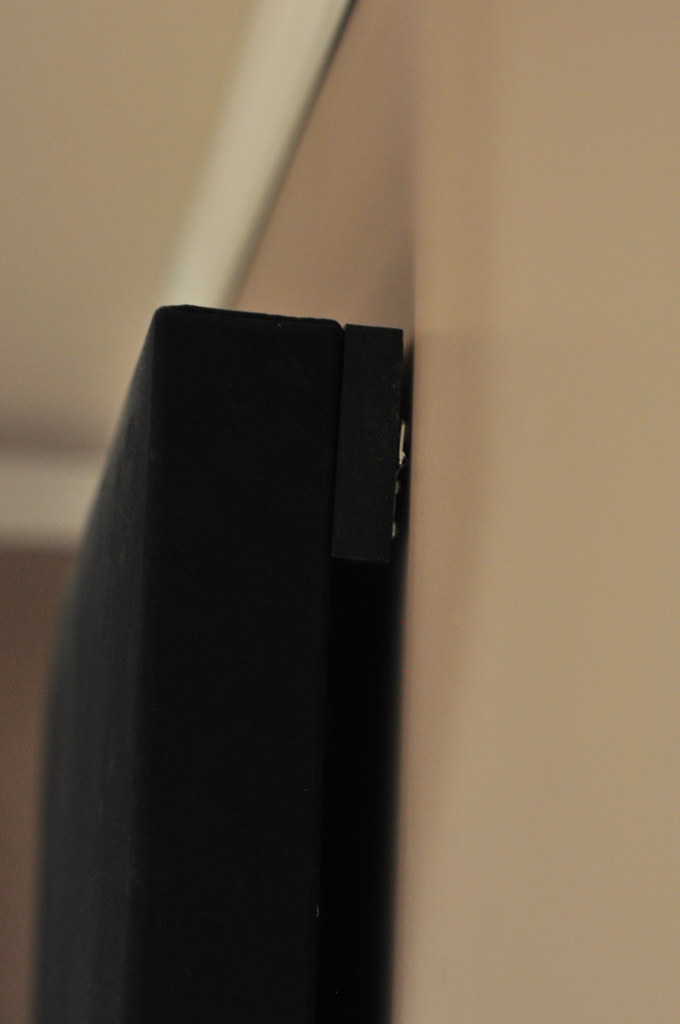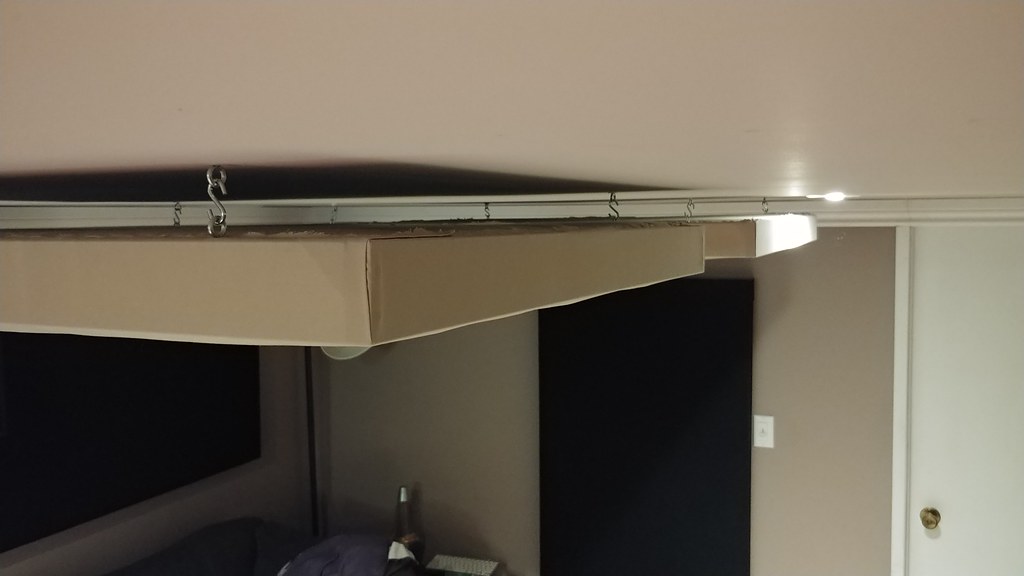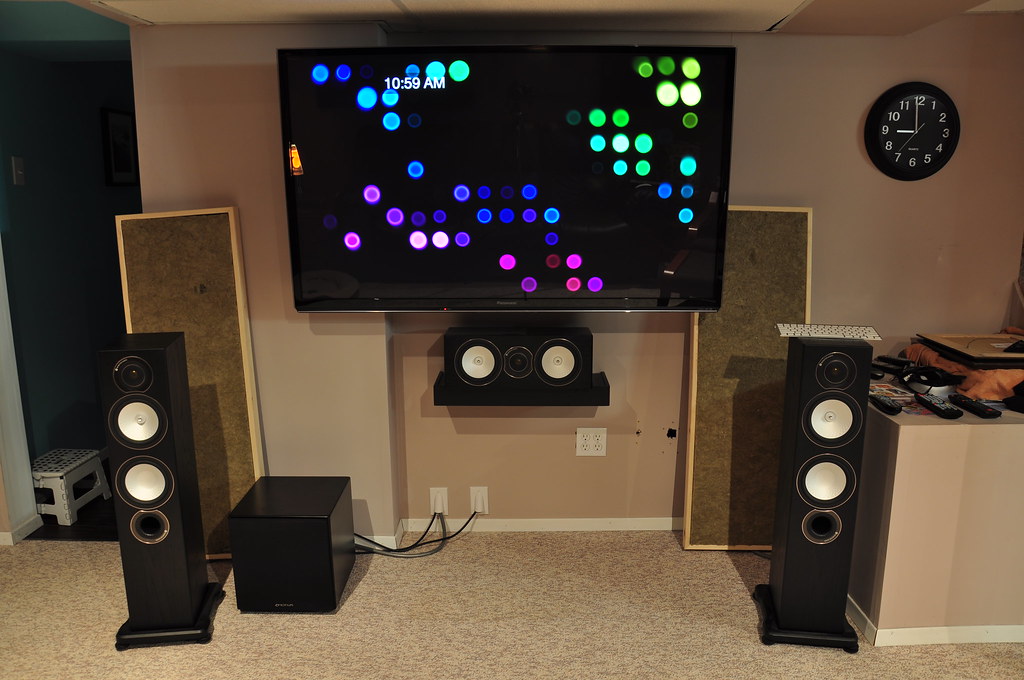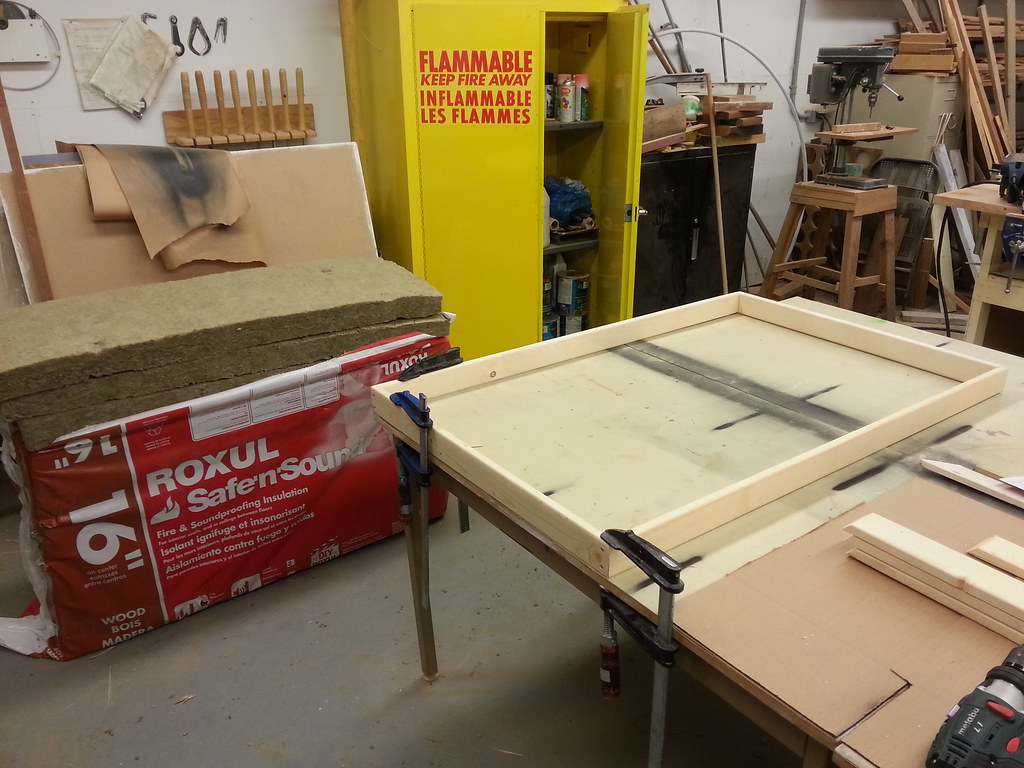|
|
Post by rbk123 on May 31, 2019 6:54:41 GMT -5
I use silk movie posters bought off ebay framed, with the sound deadening material inside the frame. DIY of course.
|
|
|
|
Post by dsonyay on May 31, 2019 7:41:47 GMT -5
I use silk movie posters bought off ebay framed, with the sound deadening material inside the frame. DIY of course. This sounds interesting.. can you post some examples? Do you add your own insulation somehow? Any links to these movie posters? |
|
|
|
Post by Bonzo on May 31, 2019 8:31:21 GMT -5
I use silk movie posters bought off ebay framed, with the sound deadening material inside the frame. DIY of course. I need to add some low along the wall opposite my couch when I get time. Since my room is already largely Led Zeppelin decorated, I plan to completely make my own "album art" squares this same way. Panel companies that will do custom prints will not do what I want due to copyright issues and legalities. So I need to do my own. Fortunately I have access to large format digital printers so printing my own fabric won't be a problem. Should be pretty cool when I'm done. Someday... |
|
|
|
Post by rbk123 on May 31, 2019 8:34:28 GMT -5
|
|
|
|
Post by creimes on May 31, 2019 9:54:53 GMT -5
I use silk movie posters bought off ebay framed, with the sound deadening material inside the frame. DIY of course. I need to add some low along the wall opposite my couch when I get time. Since my room is already largely Led Zeppelin decorated, I plan to completely make my own "album art" squares this same way. Panel companies that will do custom prints will not do what I want due to copyright issues and legalities. So I need to do my own. Fortunately I have access to large format digital printers so printing my own fabric won't be a problem. Should be pretty cool when I'm done. Someday... depending on what size of panels you want you could also buy T-Shirts with band logo's or album artwork and cut the front out and wrap it on your panels, I've been pondering that but just need to find some 3XXL or such shirts with what I would want  Just found this site that has T-Shirts and also small to large wall tapestry that you could use to wrap over DIY Roxul panels, would cost more than just cheap wallmart sheets that I used, even the small is 59" x 51" haha www.redbubble.com/shop/music+tapestry?ref=shop_popular_topicsChad |
|
|
|
Post by Mountainbiking Fool on Jun 3, 2019 10:16:01 GMT -5
Yes, that is the size I am going to use. Have not decided on the fabric yet. Did you leave an air gap behind the panel and the wall or did you mount it directly to the wall? The wall ones are only about an inch off the wall, they are right behind my couch so I couldn't go to much, the ceiling hang 2 inches from the ceiling. Chad Another dumb question....instead of making the frames 3" deep, could I just make them 5"-6" deep and keep the insulation flush against the front of the frame leaving a gap between the insulation and the back of the frame and hang directly to the wall? |
|
|
|
Post by donh50 on Jun 3, 2019 11:01:53 GMT -5
Another dumb question....instead of making the frames 3" deep, could I just make them 5"-6" deep and keep the insulation flush against the front of the frame leaving a gap between the insulation and the back of the frame and hang directly to the wall? You'll lose some absorption from the sides and for signals arriving at an angle but it should be fine. |
|
|
|
Post by creimes on Jun 3, 2019 11:15:54 GMT -5
The wall ones are only about an inch off the wall, they are right behind my couch so I couldn't go to much, the ceiling hang 2 inches from the ceiling. Chad Another dumb question....instead of making the frames 3" deep, could I just make them 5"-6" deep and keep the insulation flush against the front of the frame leaving a gap between the insulation and the back of the frame and hang directly to the wall? It's best to have them away from the wall/ceiling as they can then absorb the sound from the front and the back, I just cut some 1x4 mdf pcs from what I built the frames out of and screwed them to the backs of the panels and mounted my hardware to hang them on that, not ideal for gap but better than nothing, when I'm home tonight I'll take some pictures of one of my panels and post it here. Chad |
|
|
|
Post by Mountainbiking Fool on Jun 3, 2019 11:34:08 GMT -5
Another dumb question....instead of making the frames 3" deep, could I just make them 5"-6" deep and keep the insulation flush against the front of the frame leaving a gap between the insulation and the back of the frame and hang directly to the wall? It's best to have them away from the wall/ceiling as they can then absorb the sound from the front and the back, I just cut some 1x4 mdf pcs from what I built the frames out of and screwed them to the backs of the panels and mounted my hardware to hang them on that, not ideal for gap but better than nothing, when I'm home tonight I'll take some pictures of one of my panels and post it here. Chad Great!! Thank you!!! I was going to ask if you could take a pic so I could see how you mounted the wall panels. |
|
|
|
Post by creimes on Jun 3, 2019 19:58:28 GMT -5
It's best to have them away from the wall/ceiling as they can then absorb the sound from the front and the back, I just cut some 1x4 mdf pcs from what I built the frames out of and screwed them to the backs of the panels and mounted my hardware to hang them on that, not ideal for gap but better than nothing, when I'm home tonight I'll take some pictures of one of my panels and post it here. Chad Great!! Thank you!!! I was going to ask if you could take a pic so I could see how you mounted the wall panels. Here are some pics, hopefully good enough, don't mind the dust on the tops haha         |
|
|
|
Post by Bonzo on Jun 3, 2019 20:34:47 GMT -5
Another dumb question....instead of making the frames 3" deep, could I just make them 5"-6" deep and keep the insulation flush against the front of the frame leaving a gap between the insulation and the back of the frame and hang directly to the wall? It's best to have them away from the wall/ceiling as they can then absorb the sound from the front and the back, I just cut some 1x4 mdf pcs from what I built the frames out of and screwed them to the backs of the panels and mounted my hardware to hang them on that, not ideal for gap but better than nothing, when I'm home tonight I'll take some pictures of one of my panels and post it here. Chad +1. Right. Exactly. If I made my own I'd also drill some big holes in the side boards so sound could enter from everywhere. But depends on the brand you buy. I got one of the name brands people like here and they have a solid back and sides, so it doesn't really matter with those. I forget, buts its an acronym, like AWT or something like that. I may change what I have if I can. Also go thicker, like 4". |
|
|
|
Post by rbk123 on Jun 3, 2019 21:32:57 GMT -5
don't mind the dust on the tops haha All that dust is helping the sound absorption from the top.
|
|
|
|
Post by donh50 on Jun 3, 2019 23:30:37 GMT -5
These panels (the most common absorbers) work by turning the velocity of the sound waves into heat -- they are velocity absorbers. (There are panels that work differently, but all of these foam/fiber/wool panels are velocity absorbers.) The heat generated is infinitesimal because the actual energy is very small despite how loud it seems to us --- 1 acoustic watt is very, very loud ("will blow your ears off" my grad prof said, decades ago) but spread over the wave's area is not enough so that you can feel the rise in temperature in your panel (not sure an IR imager would show anything from the sound wave itself; they tend to be dark and absorb more ambient/radiated heat than that generated by the sounds waves impinging on them). What does this mean for panel spacing from the wall? Well, sound waves travel toward a surface and, if the surface was perfectly stiff, stop at the boundary and are reflected back (direction depends upon the angle of arrival, the reflected energy depends upon how stiff the boundary). They hit and bounce back, but right at the boundary they hit, their velocity is zero. No velocity, no absorption. That is why an air gap makes such a big difference in the performance (2:1 to 4:1 or more increased absorption compared to no air gap -- see e.g. www.acousticmodelling.com/porous.php). Spacing them does increase their effective area a little, true, but the main benefit is that it places more of the absorber in a higher-velocity region of the sound wave. HTH - Don |
|
|
|
Post by rbk123 on Jun 4, 2019 7:49:16 GMT -5
These panels (the most common absorbers) work by turning the velocity of the sound waves into heat -- they are velocity absorbers. (There are panels that work differently, but all of these foam/fiber/wool panels are velocity absorbers.) The heat generated is infinitesimal because the actual energy is very small despite how loud it seems to us --- 1 acoustic watt is very, very loud ("will blow your ears off" my grad prof said, decades ago) but spread over the wave's area is not enough so that you can feel the rise in temperature in your panel (not sure an IR imager would show anything from the sound wave itself; they tend to be dark and absorb more ambient/radiated heat than that generated by the sounds waves impinging on them). What does this mean for panel spacing from the wall? Well, sound waves travel toward a surface and, if the surface was perfectly stiff, stop at the boundary and are reflected back (direction depends upon the angle of arrival, the reflected energy depends upon how stiff the boundary). They hit and bounce back, but right at the boundary they hit, their velocity is zero. No velocity, no absorption. That is why an air gap makes such a big difference in the performance (2:1 to 4:1 or more increased absorption compared to no air gap -- see e.g. www.acousticmodelling.com/porous.php). Spacing them does increase their effective area a little, true, but the main benefit is that it places more of the absorber in a higher-velocity region of the sound wave. HTH - Don Keith would be proud of this post. No doubt he'd have made it 3 times longer, but I think you captured his essence quite well. Nicely done. |
|
|
|
Post by creimes on Jun 4, 2019 8:06:45 GMT -5
These panels (the most common absorbers) work by turning the velocity of the sound waves into heat -- they are velocity absorbers. (There are panels that work differently, but all of these foam/fiber/wool panels are velocity absorbers.) The heat generated is infinitesimal because the actual energy is very small despite how loud it seems to us --- 1 acoustic watt is very, very loud ("will blow your ears off" my grad prof said, decades ago) but spread over the wave's area is not enough so that you can feel the rise in temperature in your panel (not sure an IR imager would show anything from the sound wave itself; they tend to be dark and absorb more ambient/radiated heat than that generated by the sounds waves impinging on them). What does this mean for panel spacing from the wall? Well, sound waves travel toward a surface and, if the surface was perfectly stiff, stop at the boundary and are reflected back (direction depends upon the angle of arrival, the reflected energy depends upon how stiff the boundary). They hit and bounce back, but right at the boundary they hit, their velocity is zero. No velocity, no absorption. That is why an air gap makes such a big difference in the performance (2:1 to 4:1 or more increased absorption compared to no air gap -- see e.g. www.acousticmodelling.com/porous.php). Spacing them does increase their effective area a little, true, but the main benefit is that it places more of the absorber in a higher-velocity region of the sound wave. HTH - Don Keith would be proud of this post. No doubt he'd have made it 3 times longer, but I think you captured his essence quite well. Nicely done. Though that statement is true, sound waves are turned into heat, sometimes when I really have the volume pumpin my panels start to glow, but I have to have all the lights off...even the lava lamp    |
|
|
|
Post by selind40 on Jun 4, 2019 8:20:21 GMT -5
Dude.....your workshop is impressive, the HazMat locker alone is enough to make even the top members of the Secret Monoblock Society envious. Do you make these for others?? Thanks  |
|
|
|
Post by creimes on Jun 4, 2019 9:01:18 GMT -5
Dude.....your workshop is impressive, the HazMat locker alone is enough to make even the top members of the Secret Monoblock Society envious. Do you make these for others?? Thanks  The workshop is actually at my work, big oversized dbl garage, I work for one of Canada's biggest telecom companies, we are lucky enough to have a wood working shop in our yard, it is more so a shop that is for retired members but we are all able to use it but only about 2 or 3 of us do. I have thought about it but it may be a hassle to try and ship panels like this, at one point it crossed my mind in making and selling them. Oh and the locker is for paint and chemical storage  Chad |
|
|
|
Post by Mountainbiking Fool on Jun 4, 2019 9:27:08 GMT -5
Those turned out really nice. Good idea about the MDF on the back, I think that is what I am going to do. I want to chamfer the edges, at least on one, so I can see what it looks like. I was also thinking about cutting the panels in half so I can have 2 15.25" X 24.0" and place 3 of these in each panel, if I do this, I can make a 24"'X 45.75" panel. I could get 8 panels out of 1 bag of the rockwool. |
|
|
|
Post by creimes on Jun 4, 2019 9:57:42 GMT -5
Here are some pics, hopefully good enough, don't mind the dust on the tops haha  Those turned out really nice. Good idea about the MDF on the back, I think that is what I am going to do. I want to chamfer the edges, at least on one, so I can see what it looks like. I was also thinking about cutting the panels in half so I can have 2 15.25" X 24.0" and place 3 of these in each panel, if I do this, I can make a 24"'X 45.75" panel. I could get 8 panels out of 1 bag of the rockwool. You can also easily cut the Roxul with a serrated knife(Bread Knife) to make any size you desire. |
|
|
|
Post by donh50 on Jun 4, 2019 11:40:32 GMT -5
These panels (the most common absorbers) work by turning the velocity of the sound waves into heat -- they are velocity absorbers. (There are panels that work differently, but all of these foam/fiber/wool panels are velocity absorbers.) The heat generated is infinitesimal because the actual energy is very small despite how loud it seems to us --- 1 acoustic watt is very, very loud ("will blow your ears off" my grad prof said, decades ago) but spread over the wave's area is not enough so that you can feel the rise in temperature in your panel (not sure an IR imager would show anything from the sound wave itself; they tend to be dark and absorb more ambient/radiated heat than that generated by the sounds waves impinging on them). What does this mean for panel spacing from the wall? Well, sound waves travel toward a surface and, if the surface was perfectly stiff, stop at the boundary and are reflected back (direction depends upon the angle of arrival, the reflected energy depends upon how stiff the boundary). They hit and bounce back, but right at the boundary they hit, their velocity is zero. No velocity, no absorption. That is why an air gap makes such a big difference in the performance (2:1 to 4:1 or more increased absorption compared to no air gap -- see e.g. www.acousticmodelling.com/porous.php). Spacing them does increase their effective area a little, true, but the main benefit is that it places more of the absorber in a higher-velocity region of the sound wave. HTH - Don Keith would be proud of this post. No doubt he'd have made it 3 times longer, but I think you captured his essence quite well. Nicely done. Not sure if that is good or bad, but I am an engineer (EE) FWIW. Usually means any knowledge is disregarded by audiophiles... And, while I had some grad classes in acoustics long ago, worked in the field for a bit, and have tinkered with audio ever since, it is not my day job. |
|

